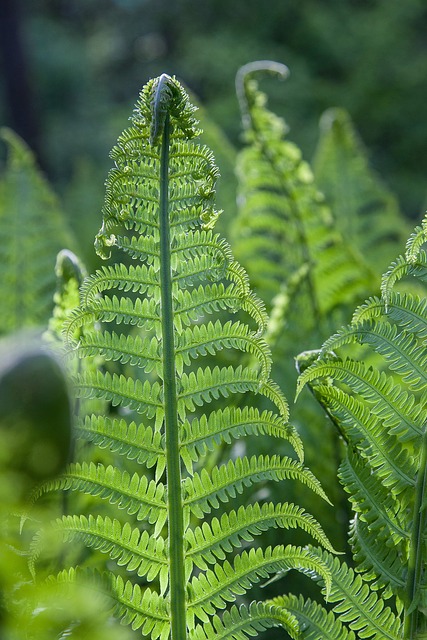 |  |  |   |  |
 |  |
The ostrich Fern is a large fern with a thick, vertical taproot.
Leaves are dimorphic, vegetatively sterile photosynthetic leaves (trophophylls), up to one and a half meters (in Europe) or up to four meters (in Asia).
Double tufted, forming a funnel, in the middle of which there are fertile spore-bearing leaves (sporophylls) with cylindrical segments in which sori are hidden. Sporophylls later become trophophylls, the outer leaves resemble an ostrich feather.
The sporophylls of ostrich Fern are light green at first, later turning dark green, contrasting with the pale green, sterile leaves. In autumn, the sterile leaves fall off, but the spore leaves remain for the winter. In the spring, the spores are released and sown.
The plant reproduces by spores and stolons. The large spores germinate in the spring when there is sufficient moisture. Spores contain a lot of chloroplasts, hence their green color.
Rhizomes, leaves and spores are collected for medicinal purposes. Roots are dug in autumn, cleaned from the soil, fine roots are separated. Cut lengthwise so as not to separate last year's leaf stalks. Dry in a well-ventilated and shaded place. It is permissible to wrap them in the sun beforehand.
Collect the spore-bearing leaves from June to September. They are spread in a thin layer on the paper or hung above it so that the spores fall on the paper as they dry.
The chemical composition of the ostrich Fern has been little studied. There is evidence that the leaves contain 650mg% vitamin P. Tannins (<4.5%), coumarin derivatives (<0.34%), up to 95mg% ascorbic acid, traces of essential oils, up to 0.12% phloroglucin derivatives have been found in the roots of the plant. Leaves <4% tannins, <0.6% coumarin derivatives, 86mg% ascorbic acid. Flavonoids have also been found in the leaves and rhizomes.
Medicinal significance
The root of ostrich Fern fern is an excellent remedy for leucorrhoea and painful menstruation. It is also used as an astringent, antitussive and antihelminthic, and it also helps with dyspnea.
The leaves of the plant are used as a sedative, anticonvulsant, antiepileptic and antispasmodic agent. Spores, on the other hand, treat eczema and heal wounds. Spores and the surface part of the plant have an anti-inflammatory and antiseptic effect.
Preparations of ostrich Fern have been known in folk medicine for a long time. A decoction of rhizomes was used as a remedy for helminths, while applications were made from the leaves to reduce bone pain.
In ancient times, ostrich Fern rhizomes were used to treat leucorrhoea, heavy menstruation, cough, shortness of breath. Used as an astringent, used to reduce fever and treat malignant tumors.
Alcoholic extracts were used to treat panic, nocturnal incontinence, convulsions, epilepsy, intestinal and stomach pains, and were used as a sedative.
In case of frostbite, burns and injuries, ostrich Fern spores were used as an anti-inflammatory agent.
